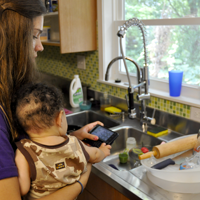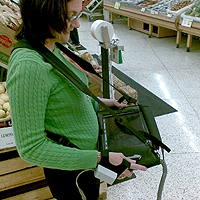|
Size: 3405
Comment:
|
Size: 6342
Comment:
|
| Deletions are marked like this. | Additions are marked like this. |
| Line 1: | Line 1: |
| {{{#!wiki yellow/solid This page is a stub. It's just something to get notes down, and is not final in any way. }}} |
Over the years, the reaction to my job title "mobile interaction designer" has migrated from blank stares. Still only about half the time does anyone have any idea what I mean. And if they do, they almost always assume it's designing mobile phones, or apps for them. |
| Line 5: | Line 3: |
| Outline eras of mobile... | {{attachment:IntroWhatMobile-paige-biking.png||align="right"}} {{attachment:IntroWhatMobile-Lilly-Mom.png||align="right"}} {{attachment:IntroWhatMobile-SymbolHyVee.png||align="right"}} {{attachment:IntroWhatMobile-MeSnowy.png||align="right"}} Occasionally, someone asks if we also design games for the Nintendo DS, or make maps for GPS navigation, or do work for some other sort of device. Has the definition of mobile changed? This is a list of the types of things I looked at to find and validate these patterns: * Mobile smartphones * Mobile featurephones * Mobile network access points (Aircards) * MIDs * Tablets * eReaders * Media players * Image viewers and digital picture frames * Portable game systems * Remote controls * Hand-held navigation devices * Portable scanners * Cameras and other capture devices * Printers, scanners, copiers and mopiers (MFDs) * Kiosks * Wearable computers * Telematics, and vehicle-mounted devices * Industrial automation * Portable surveying, measuring and metering equipment I am sure a lot of others were left out. While these share many characteristics, many are not particularly mobile. Kiosks are by definition bolted to the ground, for example. And no one much thinks of a camera as similar to a phone. So my first answer is that "mobile" is not a useful word, and that this book addresses a lot of these devices. Their design can be informed by the mobile patterns in this book and elsewhere. The ubiquity of mobiles also may mean that employing these as universal patterns is a good thing, as users may require less training when using interfaces to which they are accustomed. If you design cameras, or printers, you should be paying attention to the state of the art in mobile. == Really finding a definition == I didn't come up with this answer out of the blue, or just trust instinct. Instead, years of work, discussion, writing, and arguing led to some principles of "what is mobile." I like to think of the evolution of mobile telephony as being in four eras: |
| Line 11: | Line 47: |
| If you consider a current mobile phone as a generally 4th era device instead, what you find is they are: * Small - Enough to be carried around essentially all the time * Portable - Battery powered * Connected - Wirelessly. Not attached to the wall. * Interactive - Inherently. Unlike a watch, or even most MP3 players, which are limited' |
Yes, this leaves out a lot of interesting devices that are on the big list above. The Gameboy and GPS receivers pre-date what most of us would call mobile phones by several years. But mobile telephony is what changed the world, and ushered in all this, so it's a good anchor point. |
| Line 17: | Line 49: |
| This means that all sorts of other devices, like tablets and MIDs and game devices, are Mobile. | If you consider a current mobile phone as a generally "4th era" device what you find is they are: * Small - Small enough to carry with you all the time. Preferably in a pocket. * Portable - Battery powered and otherwise independent of the world, so it doesn't have to be plugged in or attended to regularly. * Connected - Wirelessly. Not attached to the wall or connected only when the user makes special effort. Whenever possible, connected in multiple ways, to both voice and data networks. * Interactive - Inherently. Unlike a watch, or even most MP3 players, which are limited to display, playback and a small subset of interactions, more undirected actions can be taken, such as text entry and keyword search. * Contextually-aware - The device (or services it is attached to) uses it's ability to understand the network to which it is attached, and it's other sensors to help the user get things done, and pre-emptively gather information. |
| Line 19: | Line 56: |
| More interestingly, if you start losing individual definitions, even more comes into play. GPS devices are only a bit unconnected; some have full network, some have FM traffic reports. But why draw a bright line between them based on connectivity, if all other factors are the same, and you design them the same way? | With this many facets, it's easy to disregard any one, and still feel the device meets our needs. Strapping an iPad to a wall and calling it a kiosk simply removed the "portable" feature, so it's still a "mobile" device. |
| Line 21: | Line 58: |
| This leads to definitions more related to "small screen" and "interactive." It lets even embedded devices (printers), media-capture (camera) and playback (mp3) devices play. And actually looking at the patterns, the vast majority apply to all these device. | Consider the Wii, or X-Box Kinect instead. Though the display is not at all portable, they are at their core aware of user position, they change with the type of input being used, and the entire interface has been designed to support interaction via a game controller, or simply waving your arms at the screen. These meet the interactive criteria to be a "mobile" device. |
| Line 23: | Line 60: |
| I think if you consider the convergence chart (not originally from, but visible at http://shoobe01.blogspot.com/2010/10/f8-and-be-there-what-mobile-convergence.html), and consider what happens to all those converged devices, interesting things occur. Now, what if you take out the backbone, and let there be MIDs (iTouch, etc.) that do everything but telephony? Might be good as an anchor to build the argument from, or another axis of argument. Plus, nice image. | Now take a Windows tablet PC. It has pen and touch input, can be quite small and portable, is networked, and has sensors. But I argue it is not mobile. It's not really connected, because it does so like a desktop, so you have to open dialogues and press buttons. It isn't usefully interactive, because you cannot use it on the go, but have to stop to use it. It's not contextually-aware, because the GPS, or camera, or accelerometers don't do much of anything by themselves. |
| Line 26: | Line 63: |
| OTHER THOUGHTS: | == What type of patterns we will cover == So, while this book does still focus on the classic answer, the mobile phone and especially the smartphone, similar interactions from kiosks to game stations to telematics, are also considered. In some cases, I'll even refer to these devices directly in the patterns. |
| Line 28: | Line 66: |
| This needs work. Some of us think it's all small screen devices. Connected or not. | The patterns are guidelines for implementing interaction design on these devices. So they talk about page-level components like scrollbars, display components like pop-ups, widgets like buttons, and input methods like keyboards. |
| Line 30: | Line 68: |
| Connectivity away from the wall is another definition. But kills many game devices. And actually, GPS, and so on, since they are receiving only. | But they also talk about things like the labels and lights for hardware keyboards. You might ask yourself why I do this? You can't influence it, after all. But you can. You can fail to implement correctly, and cause keyboard entry to fail. You can change scrollbar behavior, if there's a special case for your application. Increasingly, as HTML5 technologies roll out, mobile websites can take advantage of interesting interactive features. |
| Line 32: | Line 70: |
| Restrictive interactions also seems valid. At least as an edge case; why can't the same patterns be applied very often to say the LCD on your photo-printing inkjet? | And you might even be working on a device operating system. More likely, the GUI layer on top of an existing OS, but I have on multiple occasions. There are many, many devices, and new classes still emerging. Overlays have migrated down to the point that end users may change the basic behavior of their handset. You may have to work in this space sooner than you think. |
| Line 34: | Line 72: |
| Need to define this. What's your opinion? | If not, then you still need to understand why certain OS level behaviors are standard, or should not be, so you can make informed decisions about your design. |
| Line 37: | Line 75: |
| == What Patterns Do You Cover? == Good question. And right now, it's purposefully muddled. We don't generally talk about hardware, except for labels and key functions and and keyboard layouts. Because those are pretty easy to change, and directly impact the on-screen interactions. Though we /could/ talk about how people with gloves, or dry fingers, or who just hate touchscreens should also have a scroll-and-select keys, at least as backup. But, that's pretty high level handset design, so not really worth fighting in a book like this. So, the definition is pretty much '''on-screen, and things that directly impact the on-screen experience that are plausible to consider changing''', for at least an operator/carrier to change, even if not everyone can. If you have the ability to influence hardware design, then you can still get some hints from the patterns and principles contained here. We also, likewise, make lots of references to complying with the principles of the OS, as well as having principles that may conflict with any particular OS. So, if you design operating systems, then you have some other patterns and principles and guidelines to work off as well. |
Next: [[What is a Pattern?]] |
Over the years, the reaction to my job title "mobile interaction designer" has migrated from blank stares. Still only about half the time does anyone have any idea what I mean. And if they do, they almost always assume it's designing mobile phones, or apps for them.




Occasionally, someone asks if we also design games for the Nintendo DS, or make maps for GPS navigation, or do work for some other sort of device. Has the definition of mobile changed? This is a list of the types of things I looked at to find and validate these patterns:
- Mobile smartphones
- Mobile featurephones
- Mobile network access points (Aircards)
- MIDs
- Tablets
- eReaders
- Media players
- Image viewers and digital picture frames
- Portable game systems
- Remote controls
- Hand-held navigation devices
- Portable scanners
- Cameras and other capture devices
- Printers, scanners, copiers and mopiers (MFDs)
- Kiosks
- Wearable computers
- Telematics, and vehicle-mounted devices
- Industrial automation
- Portable surveying, measuring and metering equipment
I am sure a lot of others were left out. While these share many characteristics, many are not particularly mobile. Kiosks are by definition bolted to the ground, for example. And no one much thinks of a camera as similar to a phone.
So my first answer is that "mobile" is not a useful word, and that this book addresses a lot of these devices. Their design can be informed by the mobile patterns in this book and elsewhere. The ubiquity of mobiles also may mean that employing these as universal patterns is a good thing, as users may require less training when using interfaces to which they are accustomed. If you design cameras, or printers, you should be paying attention to the state of the art in mobile.
Really finding a definition
I didn't come up with this answer out of the blue, or just trust instinct. Instead, years of work, discussion, writing, and arguing led to some principles of "what is mobile."
I like to think of the evolution of mobile telephony as being in four eras:
- Voice
- Paging and Text
- Pervasive network connectivity
- General computing devices
Yes, this leaves out a lot of interesting devices that are on the big list above. The Gameboy and GPS receivers pre-date what most of us would call mobile phones by several years. But mobile telephony is what changed the world, and ushered in all this, so it's a good anchor point.
If you consider a current mobile phone as a generally "4th era" device what you find is they are:
- Small - Small enough to carry with you all the time. Preferably in a pocket.
- Portable - Battery powered and otherwise independent of the world, so it doesn't have to be plugged in or attended to regularly.
- Connected - Wirelessly. Not attached to the wall or connected only when the user makes special effort. Whenever possible, connected in multiple ways, to both voice and data networks.
- Interactive - Inherently. Unlike a watch, or even most MP3 players, which are limited to display, playback and a small subset of interactions, more undirected actions can be taken, such as text entry and keyword search.
- Contextually-aware - The device (or services it is attached to) uses it's ability to understand the network to which it is attached, and it's other sensors to help the user get things done, and pre-emptively gather information.
With this many facets, it's easy to disregard any one, and still feel the device meets our needs. Strapping an iPad to a wall and calling it a kiosk simply removed the "portable" feature, so it's still a "mobile" device.
Consider the Wii, or X-Box Kinect instead. Though the display is not at all portable, they are at their core aware of user position, they change with the type of input being used, and the entire interface has been designed to support interaction via a game controller, or simply waving your arms at the screen. These meet the interactive criteria to be a "mobile" device.
Now take a Windows tablet PC. It has pen and touch input, can be quite small and portable, is networked, and has sensors. But I argue it is not mobile. It's not really connected, because it does so like a desktop, so you have to open dialogues and press buttons. It isn't usefully interactive, because you cannot use it on the go, but have to stop to use it. It's not contextually-aware, because the GPS, or camera, or accelerometers don't do much of anything by themselves.
What type of patterns we will cover
So, while this book does still focus on the classic answer, the mobile phone and especially the smartphone, similar interactions from kiosks to game stations to telematics, are also considered. In some cases, I'll even refer to these devices directly in the patterns.
The patterns are guidelines for implementing interaction design on these devices. So they talk about page-level components like scrollbars, display components like pop-ups, widgets like buttons, and input methods like keyboards.
But they also talk about things like the labels and lights for hardware keyboards. You might ask yourself why I do this? You can't influence it, after all. But you can. You can fail to implement correctly, and cause keyboard entry to fail. You can change scrollbar behavior, if there's a special case for your application. Increasingly, as HTML5 technologies roll out, mobile websites can take advantage of interesting interactive features.
And you might even be working on a device operating system. More likely, the GUI layer on top of an existing OS, but I have on multiple occasions. There are many, many devices, and new classes still emerging. Overlays have migrated down to the point that end users may change the basic behavior of their handset. You may have to work in this space sooner than you think.
If not, then you still need to understand why certain OS level behaviors are standard, or should not be, so you can make informed decisions about your design.
Next: What is a Pattern?
